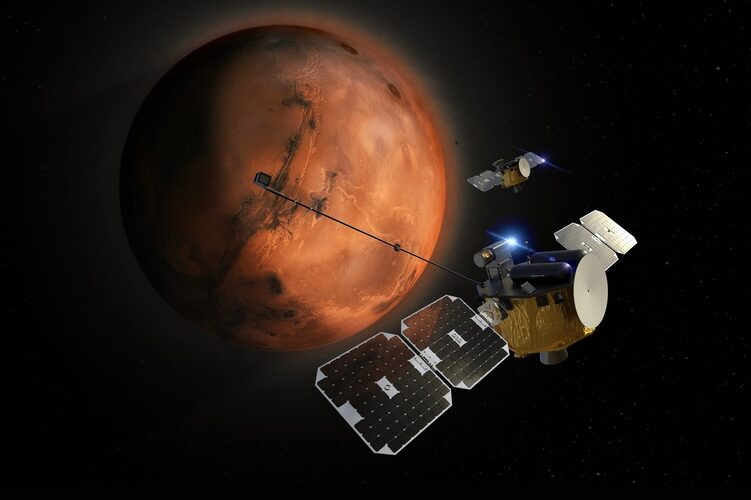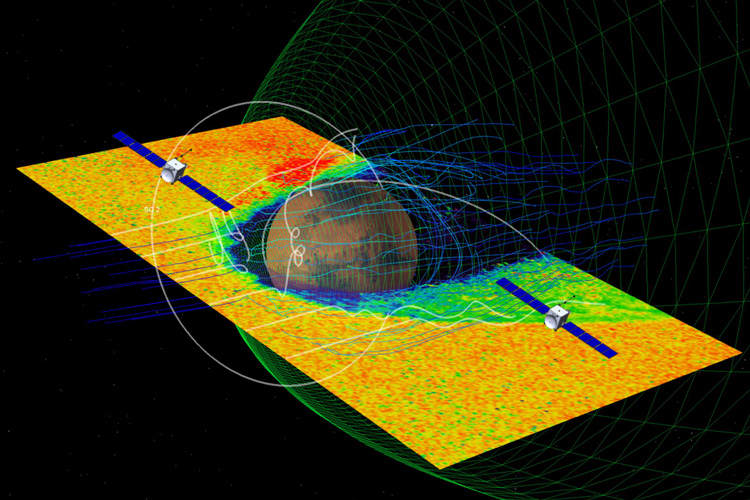‘Blue’ and ‘Gold’ satellites headed to Mars in 2024

An interplanetary mission led by the University of California, Berkeley, to put two satellites — dubbed “Blue” and “Gold” — into orbit around Mars has been officially authorized to prepare for launch in October 2024.
The announcement last week by NASA means that by 2026 the spacecraft will likely be exploring the red planet’s atmosphere and its interaction with the solar wind.
Called the Escape and Plasma Acceleration and Dynamics Explorers (ESCAPADE) mission, it is the culmination of two years of intense work by scientists at UC Berkeley’s Space Sciences Laboratory (SSL) to show that relatively inexpensive spacecraft — the design, build, test, integration and launch will cost less than $80 million — can be assembled in a short period of time to explore other planets. Typical NASA planetary missions often require more than a decade of preparation and can exceed $1 billion in costs.
“ESCAPADE and two other NASA missions recently approved are experiments to see whether advances in the space industry over the last five to 10 years can translate to a much better bang for the buck in terms of science per dollar,” said mission leader Robert Lillis, SSL’s associate director for planetary science and astrobiology. “Sending two spacecraft to Mars for the total cost of under $80 million is just unheard of, but current NASA leadership is taking the risk.”
The UC Berkeley team will work with Rocket Lab, a space contractor based in Long Beach, California, which will supply two Photon spacecraft to house and support the instruments. The academic/industry collaboration is an example of what NASA hopes to encourage with its Small Innovative Missions for Planetary Exploration (SIMPLEx) program, designed to fund compelling planetary space science with small satellites and provide more opportunities for flight experience to the science community.
These missions represent “a new commercial, higher risk, high reward way of doing things,” Lillis said. “Instead of spending $800 million for a 95% chance of success, can we spend $80 million for an 80% chance? This is what NASA is trying to find out with these missions, and we are lucky to be one of the guinea pigs.”

The mission’s goal is to collect data that could help reconstruct the climate history of Mars and determine how and when it lost its atmosphere, which was once dense enough to allow for running water, including rivers, lakes and possibly oceans. ESCAPADE also will study the ionosphere of Mars, which can interfere with radio communications on the surface and between Earth and Mars colonists.
“With simultaneous two-point observations of the solar wind and Mars’ ionosphere and magnetosphere, ESCAPADE will bring us the first ‘stereo’ picture of this highly dynamic plasma environment,” Lillis said.
“This constellation of two satellites at Mars will answer big questions about the atmosphere and the solar wind in real time,” said Shannon Curry, project scientist for the mission at UC Berkeley.
Rocket Lab, which teamed with UC Berkeley in June, has been building rockets and spacecraft platforms since 2006 for civil, defense and commercial customers. NASA evaluated the mission’s preliminary design and project plan and determined last week that both UC Berkeley and Rocket Lab had met all milestones — called key decision points — necessary to prepare for launch. The next steps include the final design of the mission and building the instruments.
“ESCAPADE is an innovative mission that demonstrates that advanced interplanetary science is now within reach for a fraction of traditional costs, and we’re proud to make it possible with Photon,” said Rocket Lab founder and CEO Peter Beck in a statement. “Passing the key decision point is a critical milestone in ESCAPADE’s development and is testament to the world-class science and engineering work of the UC Berkeley and Rocket Lab teams. We are delighted to receive the green light from NASA to proceed to flight.”
The mission builds on decades of experience at SSL in building satellite instruments and fleets of spacecraft to explore regions around Earth, the moon and Mars, specializing in magnetic field interactions with the wind of particles from the sun. Each of the two satellites, named after UC Berkeley’s school colors, will carry instruments built at SSL to measure the flow of high energy electrons and ionized oxygen and carbon dioxide molecules escaping from Mars, magnetic field detectors built at UCLA and a probe to measure slower or thermal ions built at Embry-Riddle Aeronautical University in Daytona Beach, Florida.
With twin satellites, it is possible to measure conditions simultaneously at two places around the planet, Lillis said, allowing scientists to connect plasma conditions at one site to the escaping ion flux at another. Over the course of the mission, the two satellites will change positions to map the upper atmosphere and magnetosphere of nearly the entire planet from an altitude of between 150 and 10,000 kilometers.
When selected by NASA in 2019 to receive $8.3 million for a conceptual design, ESCAPADE was scheduled to piggyback aboard a rocket that was launching another mission, called Psyche, in August 2022. But that opportunity evaporated when the launch vehicle was changed, and NASA looked for another option. The agency eventually deciding to launch ESCAPADE as a secondary payload aboard a different, as-yet-unselected commercial rocket
“For ESCAPADE, we’re evaluating a number of rideshare options to enable this critically important science while also lowering costs,” said Alan Zide, program executive for the mission at NASA headquarters, in a blog post on NASA’s website.
As a result, while the instruments remain unchanged, they have to be reconfigured to fit the Photon platform.
“The instruments haven’t changed, the science objectives haven’t changed, but everything from the launch pad to the orbit in space is completely different,” Lillis said. “We are going with a brand new contractor, a different propulsion system and a very much shorter mission plan in getting to Mars.”
The trip to Mars will take about 11 months, after which Blue and Gold will separate and start their mission.
Lillis said that his reaction to NASA’s decision was “just unbridled joy and happiness,” but admitted that he won’t rest easy until early in 2026, “when we get our first data from orbit around Mars.”
RELATED INFORMATION
